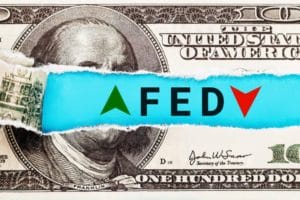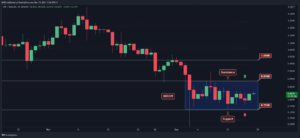
At 8:00 PM (CET) last night at the FOMC, Jerome Powell, the Fed Chairman, announced an interest rate increase of 75 basis points.
Fed’s rate hike continues
Last night’s announcement by Federal Reserve Chairman Jerome Powell at the FOMC was an increase of 75 basis points, bringing total US interest to 3.25%, the highest since 2008 confirming the steady hand of monetary policy in the United States of America.
The increase follows the excellent results so far found by the iron fist of the US central bank, which in June had achieved a drop in the inflation figure even slightly above expectations and in response decided to continue at the same pace.
As soon as yesterday’s Fed verdict was pronounced, markets breathed a sigh of relief as it had long been expected that the interest rate hike would be at least 75 points, with some analysts fearing an increase of as much as 100 basis points.
Since the 1990s, the Fed has never raised interest rates by a full percentage point, according to statistics in history.
The fear was real, compounded by statements from the US central bank and its entourage suggesting that an increase of this magnitude was likely to occur also at once should economic conditions be such as to require such invasive intervention.
Last week there was a 48% expectation of a full percentage point increase by the Fed while markets had priced in only 75 basis points. If it had actually gone toward 100 basis points it could have driven markets even lower.
The US inflation rate of 8.3% found in June this year is at the lowest level since April 2022, which we hope could have been the peak of this inflation run.
Within this scenario, which gives a better light to the markets and reassures investors, there nevertheless lingers the question of how long this rate hike will last in response to a major CPI, the fear being the possibility that interest rates may remain higher for a longer period of time when it will become necessary to let up with increases and fight with the weapon of persistence.
Rising rates and the struggle between the Fed and inflation
Powell expects a maximum total rate increase of between 100 and 125 basis points between now and the end of the year, which leads one to think that pending the next inflation data that may confirm or reverse this plan, the Fed’s decision on the current 75 basis point increase seems unlikely to be replicated in the future, at least this year.
Analysts’ estimates agree that at the next CPI data we will still have a decline in inflation although it is believed that this will be minor.
While all the macroeconomic data suggest that the future sees a sharp slowdown in the US economy, the result of the intersection of multiple factors, such as inflation, tensions with China, rising commodity costs, strong US dollar, employment data, and so on, the recession much hailed by many does not seem to be leaving the picture but is being scaled back and is expected to do less damage than expected, thanks also to a strong US economy with employment at excellent levels and consumption more or less stable despite the price increases.
When the employment figure worsens and the cuts (expected to be about 10/15%) in corporate payrolls arrive, the result of shrinking balance sheets, a strong dollar and difficulties in finding raw materials, then the Fed will be backed against the wall and will have to decide whether to save the American economy and the social fabric, rather than correct inflation and perhaps accept a CPI slightly higher than normal.
Chairman Powell, stated:
“From the perspective of our Congressional mandate to support maximum employment and price stability, the current picture is clear: the labor market is extremely tight and inflation is too high. As the monetary policy stance further tightens, it will probably become appropriate to slow down the pace of increases.”
US and the recession
A country is officially in recession when GDP data are negative for at least two consecutive quarters. This is what is in the textbooks, but the theme seems to have recently been called into question.
At the previous FOMC meeting, Powell and co. downplayed the recession, going so far as to say first of all that it does not depend on a single data point, which is partly true, and furthermore, America sees no danger of a recession given the strength of its economy.
Also in the previous FOMC, the Federal Reserve had explained.
“Recent spending and production indicators have weakened. However, earnings on the labor front in recent months have been robust and the unemployment rate has remained low. Inflation remains high, reflecting supply and demand imbalances related to the pandemic, rising food and energy prices and wider price pressures. Russia’s war against Ukraine is causing enormous human and economic damage.
War and related events are creating further upward pressure on inflation and weighing on global economic activity. The Committee is highly attentive to inflationary risks and seeks to obtain maximum employment and to bring inflation to 2% in the long run. In support of these objectives, the Committee has decided to increase the target range for the federal funds rate to the range of 2.25% -2.50%. In addition, the Committee will continue to reduce its holdings in Treasury and corporate bonds and mortgage-backed securities.”
Never in 40 years has the Federal Reserve raised rates for three consecutive 75-basis-point increases.
The post Fed announces rate hike of 75 basis points appeared first on The Cryptonomist.






















